 W
WThe Baligród massacre occurred on Sunday, 6 August 1944 in Baligród, Lesko County, Poland. Ukrainian nationalists with the Ukrainian Insurgent Army (UPA) entered the village of Baligród and killed 42 members of the Polish community.
 W
WThe Battle of Pęcice took place on 2 August 1944 between military units of Armia Krajowa, belonging to the 4th Ochota Sub-district, and the German military during the Warsaw Uprising in Poland during World War II.
 W
WThe Battle of Radzymin was one of a series of engagements between the 1st Byelorussian Front of the Red Army and the XXXIXth Panzer Corps of the German Army. The battle was part of the Lublin-Brest Offensive between 1 and 10 August 1944 at the conclusion of Operation Bagration the Belorussian strategic offensive operation near the town of Radzymin in the vicinity of Warsaw, part of which entailed a large tank battle at Wołomin. It was the largest tank battle on the territories of Poland during the war.
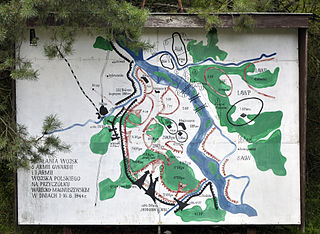 W
WThe Battle of Studzianki was a tactical engagement between elements of the Soviet Red Army's 2nd Guards Tank Army employed as a cavalry mechanized group of the 1st Belorussian Front, together with Polish 1st Armoured Brigade and elements of the German 9th Army of the Army Group North Ukraine defending the area south of Warsaw. The battle was part of the Soviet Lublin–Brest Offensive of Operation Bagration.
 W
WBloody Christmas Eve in Ochotnica Dolna – symbolic name given to pacification of the Ochotnica Dolna village, made by German Occupiers in the last months of World War II. 23 of December 1944 members of SS murdered 56 residents of Ochotnica Dolna and partially burnt the village. The name "Bloody Christmas Eve" refers to Eve of the Christmas, that previously was celebrated on 23rd of December.
 W
WThe Huta Pieniacka massacre was a massacre of the Polish inhabitants of the village Huta Pieniacka, located in modern-day Ukraine, which took place on February 28, 1944. Estimates of the number of victims range from 500, to 1,200.
 W
WThe Koniuchy (Kaniūkai) massacre was a World War II massacre of civilians, mostly women and children, carried out in the village of Koniuchy on 29 January 1944 by a Soviet partisan unit together with a contingent of Jewish partisans under Soviet command. At least 38 civilians who have been identified by name were killed, and more than a dozen were injured. In addition, houses were burned and livestock was slaughtered. It was the largest atrocity committed by the Soviet partisans in present-day Lithuania.
 W
WThe Korosciatyn massacre took place on the night of February 28/29, 1944, during the province-wide wave of massacres of Poles in Volhynia in World War II. Korosciatyn, which now bears the name of Krynica and is located in western Ukraine, was one of the biggest ethnic Polish villages of the interwar Poland’s within Buczacz County in Tarnopol Voivodeship (pictured). Located along the railway line from Tarnopol to Stanislawów, in 1939 it had some 900 inhabitants, all of them being ethnic Poles. Korosciatyn had an elementary school, a Roman Catholic church and a railway station. It belonged to the Latin Rite Roman Catholic parish of nearby Monasterzyska, which also covered several nearby villages. Among the most famous of the citizens of this parish, are Rev. Stanislaw Padewski, professor Gabriel Turowski as well as two scientists, professor Michal Lesiow of Lublin’s Maria Curie University and doctor Jan Zaleski of Krakow’s Pedagogical College. Altogether, in 1939 the Deaconry of Buczacz had around 45 000 Polish inhabitants.
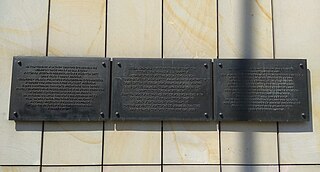 W
WThe Lipowa 7 camp was a Nazi forced labor concentration camp, primarily for Jews, by Lipowa Street in Lublin, Poland during December 1939 - 1944. In November 1943 nearly all Jewish inmates were exterminated.
 W
WThe Lvov–Sandomierz offensive or Lvov–Sandomierz strategic offensive operation was a major Red Army operation to force the German troops from Ukraine and Eastern Poland. Launched in mid-July 1944, the operation was successfully completed by the end of August.
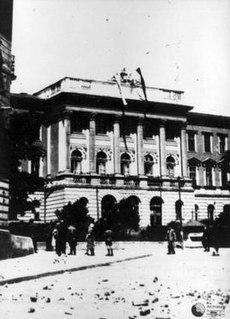 W
WThe Lwów uprising was an armed insurrection by the Home Army underground forces of the Polish resistance movement in World War II against the Nazi German occupation of the city of Lviv in the latter stages of World War II. It began on July 23, 1944 as part of a secret plan to launch the countrywide all-national uprising codenamed Operation Tempest ahead of the Soviet advance on the Eastern Front. The Lwów uprising lasted until July 27. Shortly afterwards, the Polish troops were disarmed, soldiers merged into the Polish communist armed forces and officers arrested by the Soviet NKVD. Some were forced to join the Red Army, others sent to the Gulag camps. The city itself was occupied by the Soviet Union.
 W
WMajdanek was a Nazi concentration and extermination camp built and operated by the SS on the outskirts of the city of Lublin during the German occupation of Poland in World War II. It had seven gas chambers, two wooden gallows, and some 227 structures in all, placing it among the largest of Nazi-run concentration camps. Although initially intended for forced labor rather than extermination, the camp was used to kill people on an industrial scale during Operation Reinhard, the German plan to murder all Jews within their own General Government territory of Poland. The camp, which operated from October 1, 1941, until July 22, 1944, was captured nearly intact, because the rapid advance of the Soviet Red Army during Operation Bagration prevented the SS from destroying most of its infrastructure, and the inept Deputy Camp Commandant Anton Thernes failed in his task of removing incriminating evidence of war crimes.
 W
WThe Majdanek State Museum is a memorial museum and education centre founded in the fall of 1944 on the grounds of the Nazi Germany Majdanek death camp located in Lublin, Poland. It was the first museum of its kind in the world, devoted entirely to the memory of atrocities committed in the network of slave-labor camps and subcamps of KL Lublin during World War II. The museum performs several tasks including scholarly research into the Holocaust in Poland. It houses a permanent collection of rare artifacts, archival photographs, and testimony.
 W
WThe massacres of Poles in Volhynia and Eastern Galicia, were carried out in German-occupied Poland by the Ukrainian Insurgent Army, or the UPA, with the support of parts of the local Ukrainian population against the Polish minority in Volhynia, Eastern Galicia, parts of Polesia and Lublin region from 1943 to 1945. The peak of the massacres took place in July and August 1943. Most of the victims were women and children. Many of the Polish victims regardless of age or gender were tortured before being killed; some of the methods included rape, dismemberment or immolation, among others. The UPA's actions resulted in between 50,000 and 100,000 deaths.
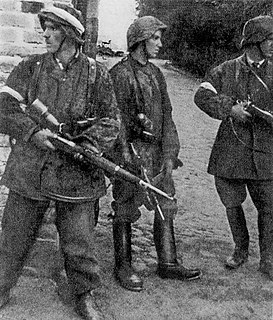 W
WOperation Most III or Operation Wildhorn III was a World War II operation in which Poland's Armia Krajowa provided the Allies with crucial intelligence on the German V-2 rocket.
 W
WOperation Kutschera was the code name for the successful execution of Franz Kutschera, SS and Reich's Police Chief in German-occupied Warsaw, who was shot on 1 February 1944 by a combat sabotage unit of Kedyw of the Home Army mainly manned by members of scouting and guiding Gray Ranks. This special action was a part of the larger Operation Heads - the code name of a series of executions of Nazi officials by the Polish Resistance.
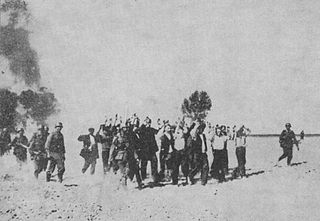 W
WThe pacification actions in German-occupied Poland during World War II were one of many punitive measures designed to inflict terror on the civilian population of local villages and towns with the use of military and police force. They were an integral part of the war of aggression against the Polish nation waged by Nazi Germany since September 1, 1939. The projected goal of pacification operations was to prevent and suppress the Polish resistance movement in World War II nevertheless, among the victims were children as young as 1.5 years old, women, fathers attempting to save their families, farmers rushing to rescue livestock from burning buildings, patients, victims already wounded, and hostages of many ethnicities including Poles and Jews.
 W
WThe Palikrowy massacre was a war crime committed by 4th police SS-regiment made up of Ukrainian soldiers of the SS-Galizien who were removed from the SS-Galizien at the time of the massacre and placed under German police command, Ukrainian SVK forces and Ukrainian Insurgent Army on Poles in the village of Palikrowy, which took place on 12 March 1944. A total of 385 Poles were killed.
 W
WThe Pidkamin massacre or the Podkamień massacre of 12 March 1944 was the massacre of Polish civilians committed by the Ukrainian Insurgent Army (UPA) under the command of Maksym Skorupsky (Maks), in cooperation with a unit of the 14th SS-Volunteer Division "Galician". The victims were ethnic Polish residents of the Eastern Galician village of Podkamień in the occupied Second Polish Republic's Tarnopol Voivodeship. During the war the area was administratively part of the Nazi German Reichskommissariat Ukraine. Estimates of victims include 150, more than 250 and up to 1000.
 W
WThe Manifesto of the Polish Committee of National Liberation, also known as the July Manifesto or the PKWN Manifesto, was a political manifesto of the Polish Committee of National Liberation (PKWN), a Soviet-backed administration, which operated in opposition to the London-based Polish government in exile.
 W
WThe Polish Committee of National Liberation, also known as the Lublin Committee, was an executive governing authority established by the communists in Poland at the later stage of World War II. It was officially proclaimed on 22 July 1944 in Chełm, installed on 26 July in Lublin and placed formally under the direction of the State National Council. The PKWN was a provisional entity functioning in opposition to the London-based Polish government-in-exile, which was recognized by the Western allies. The PKWN exercised control over Polish territory retaken from Nazi Germany by the Soviet Red Army and the Polish People's Army. It was sponsored and controlled by the Soviet Union and dominated by Polish communists.
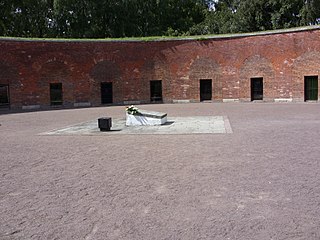 W
WThe Rotunda Zamość or the Museum of Martyrdom of the Zamość region - Rotunda, is a Polish museum devoted to remembering the atrocities committed at the former Rotunda Zamość Nazi German camp located in Zamość near Lublin. The Nazi German Gestapo camp was set up in occupied Poland during World War II, as part of the Polish extermination program known as the German AB-Aktion in Poland, Ethnic cleansing of Zamojszczyzna by Nazi Germany....
 W
WThe Uroczysko Baran killing fields, often referred to in Poland as the "Little Katyn" or the "Second Katyn", was the location for secret executions of soldiers and officers of the Polish Underground State, Home Army, and Second Army of Ludowe Wojsko Polskie carried out by Communist forces on behalf of the NKVD, SMERSH, and PUBP in the later stages of World War II.
 W
WWiśniowiec massacres . In the monastery of Discalced Carmelites and in the city Wiśniowiec (Vyshnivets) in February 1944 an armed group of the OUN massacred 300 Poles who had sought refuge there. Most people were hiding in the monastery and in the abandoned Vyshnivets Palace. At the same time in the village Wiśniowiec Stary took place another massacre, where 138 Poles were killed by UPA.